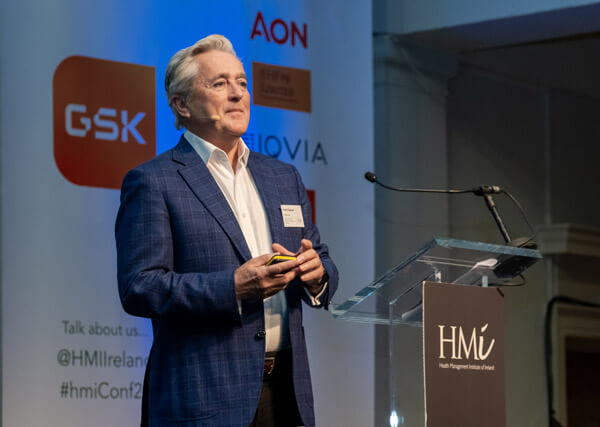
Positive health, which represented a major shift in thinking, involved developing positive organisations, developing people’s transformational leadership and having people maintain their own wellbeing, Prof. Ciaran O’Boyle, RCSI Centre for Positive Health Sciences told the Conference.
He was speaking on “Positive Leadership and Health: Engaging With Others While Thriving Oneself.”
Prof. O’Boyle said that Units that improved most by implementing six positive practices (caring, compassionate support, forgiveness, inspiration, meaning and respect, integrity and gratitude) showed significant increases in measures of patient satisfaction with pain management, organisational climate, participation in hospital affairs, foundations for equality care, resource adequacy support of nurses by managers and nurse/physician relationships.
The mission of the RCSI Centre for Positive Health Sciences, which was established in 2019, was to educate, nurture and discover to enhance health and well -being though the practice of positive psychology and lifestyle medicine. The Centre offered a broad range of undergraduate and postgraduate courses in Positive Health, as well as free online courses.
He said traditionally, health was seen as an absence of disease, with its focus on the disease process. Signs, symptoms, disability, treatment/maintenance/rehabilitation were the main focus of traditional healthcare.
With Positive Health the focus was on well-being – knowledge, skills and empowerment. The main focus of the new approaches to healthcare included positive psychology.
Positive health was both a destination and a journey. It was not just about the destination. We were starting to see specialties emerge focussing on this direction. It had just been decided in the US that doctors could be reimbursed for Lifestyle Medicine.
Prof. O’Boyle said that the organisation had more impact than the individual in terms of wellbeing. If we were to turn organisations positive we needed to change the music – create a sense of purpose, nurture authentic conversations, see possibilities, embrace the common good and trust the emergent process.
In the old days, the way to deal with a toxic organisation was to develop resilience and teach the individual to be more resilient. Now the way was to change the toxic organisation.
Transformational leadership was crucial for the development of wellbeing cultures.
The principles of Authentic Leadership were:
- Know yourself – demonstrate understanding of one’s strengths and weaknesses and the way one made sense of the world.
- Do the right thing – be guided by internal moral perspectives that were used to self-regulate one’s behaviour.
- Be genuine and compassionate – present one’s authentic self through openly sharing information and feelings as appropriate for situations.
- Be fair-minded – objectively analyse relevant data before making a decision.
He said people developed their authentic leadership through learning from their life story, becoming self-aware, practising their values and principles, balancing their extrinsic and intrinsic motivation, building their support teams, integrating their life by staying grounded and empowering people to lead.
Contrasting the Deficit vs the Abundance Approach to Leadership, he said the Deficit (or problem-solving) approach involved identifying the key problems and challenges, generating alternative solutions based on root causes, evaluating and choosing the best solutions and implementing and following up to show the problem was solved.
The role of the manager in this was identifying and solving problems, success was measured by problems solved and the focus was negative.
The Abundance Approach identified peak experiences when individuals and the organisation were at their best, identifying and understanding the enablers of optimal performance, creating sustainable impact by continuing and further developing the enablers of optimal performance and designing interventions to create an ideal desired future, based on optimal performance.
The role of the manager in this approach was identifying and actualising potential, success was measured by the triple bottom line – People, Planet, Profit and the focus was positive.
He said the aim of Lifestyle Medicine was to redesign health delivery to rely on therapeutic lifestyle interventions as a primary modality to treat, prevent, manage and reverse cardiometabolic conditions. The six pillars were nutrition, stress management, avoiding risk substances, social connection, restorative sleep and physical activity.

